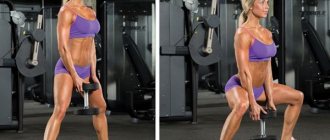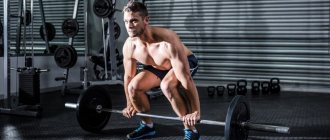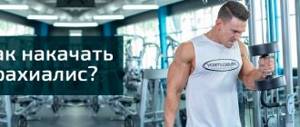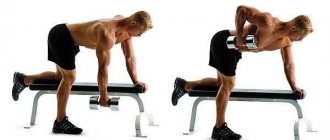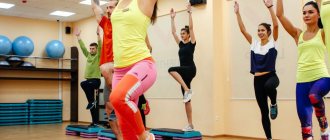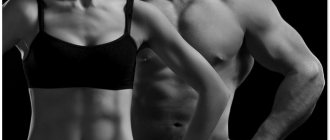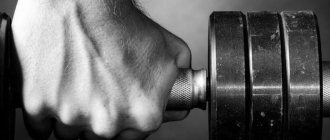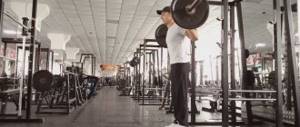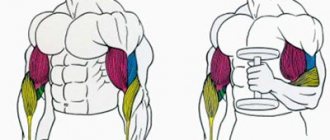Rules for performing the exercise
- Stand up straight, take two dumbbells, keep your arms along your body.
- Step forward with your right foot about 60 cm, leave your left foot motionless behind, keep your back straight. Maintain an upright body position to maintain balance. Take a breath as you step. Caution: Do not allow your knees to lean toward your toes to avoid putting undue stress on the knee joint. Make sure your shins are perpendicular to the ground.
- Push up, focusing on your heel, and return to the starting position as you exhale.
- Repeat the exercise the recommended number of times, then do it on your left leg.
Variations : There are several ways to perform this exercise.
Stand straight, hold dumbbells in your hands along your body. As you inhale, take a step forward, lowering your upper body. As you exhale, push up with your heel and return to the starting position. The exercise can be performed alternately with each leg, with dumbbells or a barbell, or with a walk-through.
Moving the leg to the side
Difficulty - medium. The inner and outer thighs and gluteal muscles work.
In the ranking of the TOP 10 exercises for the buttocks, “Leg Swings” take 5th place .
- Starting position: standing. Hands are either free or on the hip joints.
- Select the first supporting leg (let it be the left one). We lean on this limb, while exhaling we move our right leg to the side, and while inhaling we return it back.
We perform 10-15 such movements. We repeat similarly for the other leg.
What other types of leg swings are there? 4 most popular options.
This movement is shown even more clearly in the video:
What muscles work when performing lunges with dumbbells?
Conventionally, the muscles involved can be divided into two groups: main and auxiliary.
Main muscles:
- Gluteus maximus;
- External and lateral heads of the quadriceps;
- Biceps femoris muscle.
Auxiliary:
- Gluteus minimus and medius muscles;
- Abdominal muscles;
- Semitendinosus and semimembranosus (back of the thigh) muscles;
- Spinal extensor muscles;
- Adductor muscles of the thighs;
- Calf muscles.
It is worth noting that a static load is applied to the arm muscles.
Benefits of Exercise
This movement has many useful bonuses:
- Lunges belong to a group of exercises that involve asymmetrical leg work. Thanks to this, imbalances in each can be eliminated.
- It can be done at home.
- Lots of variations. Each version of the exercise has its own advantages. In addition, you can combine several variations in one workout.
- Exercise has a positive effect on the development of small stabilizer muscles, and also develops and improves coordination.
- Lunges with dumbbells do not create a strong load on the lumbar region. They can be used as an alternative to barbell exercises.
Technique options with dumbbells
Dumbbells are your most versatile equipment, with which you can diversify your workout in terms of difficulty level and quality of body work.
Lunges with dumbbells forward
Stand up straight, take dumbbells in your hands, lower your arms along your body. As you inhale, take a step forward, lowering your upper body. Keep your body straight and your shins perpendicular to the floor. As you exhale, push up and return to the starting position. Repeat the recommended number of times.
Lunges with dumbbells forward
Lunges with dumbbells back
Stand up straight, take dumbbells in your hands, lower your arms along your body. As you inhale, take a step back, lowering your upper body. Keep your body straight and your shins perpendicular to the floor. As you exhale, push up and return to the starting position. Repeat the recommended number of times.
Lunges with dumbbells back
Lunges with dumbbells
A more difficult method is Lunges with walking, when you move around the room or hall in this way. This method is suitable for more experienced athletes.
Hold dumbbells in both hands while maintaining balance. Lunge forward. The knee of the back leg almost touches the floor. Keep your back straight. Push off with the heel of your front foot, rise back up and step forward with the other leg, repeating the lunge.
Bodyweight walking lunges
Walking Lunges with Dumbbells Overhead
Lunges can also be done while holding weights on your hands to maximize the load on the stabilizer muscles of the shoulder girdle and core. This option is more suitable for professionals who have already mastered this exercise and do not have problems with balance in movement.
Hold the barbell at arm's length. Lunge forward. The knee of the back leg almost touches the floor. Keep your back straight. Push off with the heel of your front foot, rise back up and step forward with the other leg, repeating the lunge.
Walking lunges with barbell overhead
Lunges with a dumbbell under your foot
Lunges are a basic and versatile exercise for the lower body. Kettlebell lunges also allow you to train balance and stability. When performing this exercise, all the muscles of the torso work.
Lunges with weights under the foot
Back scissor lunges with dumbbells
Cross lunges allow you to effectively work your gluteal muscles. Thanks to the crossed position of the legs, similar in technique to a curtsey, the gluteal muscle receives an excellent stretch in the lower phase of the movement. Performing this exercise with dumbbells, a barbell, or even no weight at all allows you to create rounded, toned buttocks, visually lifting them and separating them from the hamstrings.
Back lunges into scissors with weight
Bulgarian split squats with dumbbells
Stand up straight, hold the weight plate in front of you at chest level. Place one leg on a hill. As you inhale, perform a squat, keeping your body motionless. As you exhale, return to the starting position. Perform the required number of times and change legs.
Bulgarian split squats with weight
Lunges with dumbbells on a bosu platform
In order to correctly perform the exercise on the bosu platform, take the starting position, and then step on the center of the hemisphere with your working leg and lunge. Be sure to focus on your heel. The back leg rests on the toe. As in the classic version of the exercise, the legs are bent at a right angle.
It is recommended to perform the exercise first on one leg and then on the other leg. To make it more challenging, you can perform reverse lunges on the Bosu platform.
Injury hazard
No other exercise will help so effectively in shaping the relief of the legs. Some athletes prefer to perform this exercise without weights, but those who strive to achieve high results use it. To avoid injury, before performing the exercise, it is imperative to warm up thoroughly and then follow safety precautions. The first approach is recommended to be performed with your own weight (without weights). Failure to follow the instructions may result in serious injury or other adverse consequences.
Bodymaster.ru recommends Fitness Trainers:
The main mistakes when doing lunges with dumbbells include:
- "Round back" Your back should be kept straight while performing lunges. The gaze is directed in front of you or slightly upward.
- Tilt of the body towards the front leg. As in the note above, the back should be straight, shoulders down, gaze forward.
- The knee of the working leg (front) “crawls out” beyond the line of the foot. We should not forget that the thigh and lower leg should form a right angle.
- Push with the back leg while lifting. The main load should be placed on the working leg. When performed correctly, the push is carried out by the heel of the front foot.
- Feet on the same line. With this position of the feet, it is very difficult to maintain the correct technique and maintain balance.
Technical errors and contraindications
When performing lunges with dumbbells, a beginner can make the following mistakes:
- Lifting by pushing off the floor with the toe of the supporting leg.
- Perform the exercise at a fast pace, jumping.
- Lack of control over posture - hunched back, rounded thoracic spine.
- Shoulders rising towards the ears with each repetition (the arm and the dumbbell in it should not move at all).
- The knee of the supporting leg moves to the sides, extending beyond the toe.
- Excessively wide or narrow legs (in both options it is much more difficult to maintain balance).
Due to technical errors, the load on the joints and spine increases sharply. On the contrary, it decreases in muscles. The natural result is pain in the knees, ankles, and back (especially in the lumbar region).
Performing lunges with dumbbells for girls and men is contraindicated if you have:
- Any history of serious injuries to the knee joints and ankles (especially during the recovery period after them).
- Chronic joint diseases (arthritis, arthrosis, gout).
- Inflammatory processes in ligaments.
- Some diseases of the nervous system, one of the symptoms of which is problems with spatial orientation.
An alternative to lunges if there are contraindications is a vertical press or bench press in a sitting position, performed with each leg in turn.
Recommendations
Consider the following simple tips. First, perform the exercise with them mentally, then without weights, and having fully understood the movement - with dumbbells.
- Lunges with dumbbells or other weights are not recommended for beginners. Beginners should begin the exercise with caution so as not to damage the ligaments. In addition, each workout should begin with a warm-up. This will help stimulate the production of joint lubrication.
- If you want to load the muscles of the buttocks more, try to take a wider step, but do not forget about the exercise technique.
- To create a greater load on the muscles, lunges with dumbbells can be performed on a step or bosu platform. In the case of a step platform, the amplitude of movement will increase. And in the case of bosu, stabilizer muscles will be additionally involved.
- If it is difficult to maintain balance during a lunge, the toe of the leading leg can be slightly turned inward.
- To increase the effectiveness of the lunge, try to stay at the bottom for a few seconds.
How to avoid getting injured
Exercises place increased stress on the ligaments of the knee joints. In this regard, they are more dangerous than squats.
This is explained by the fact that during squats, the weight of the body and weights are distributed on two limbs, and when doing lunges, you concentrate the entire load on one leg. Of course, the muscles are delighted with this, but weak ligaments may suffer. Therefore, to prevent injury, use the following recommendations:
- Avoid lunging with dumbbells if you have a recent knee injury. If there were injuries, but for a long time, do the exercise extremely carefully and stop if the slightest discomfort occurs. Take care of your health.
- Before you start training, you need to warm up the muscles and provoke the release of joint fluid. To do this, we squat and do exercises without weights, rotate our feet and shins, bend forward, etc. It will take a little time, but the effect of the training will be much higher, and the likelihood of getting injured is lower.
- When working with heavy weights, do not take steps. That is, both legs remain in place and your dumbbell lunges automatically transform into scissor squats.
- If you have not practiced physical activities before, first practice the technique without weight.
- If pain, discomfort or any other signals occur that should not normally exist, stop the exercise.
Special versions
Not enough variety? Check out these 19 options from Men's Health:
Materials used from books (many thanks to the authors and publishers for them):
Frederic Delavier - Anatomy of strength exercises for men and women
Adam Campbell - The Best Strength Exercises and Workout Plans for Men
Alternative Exercises
